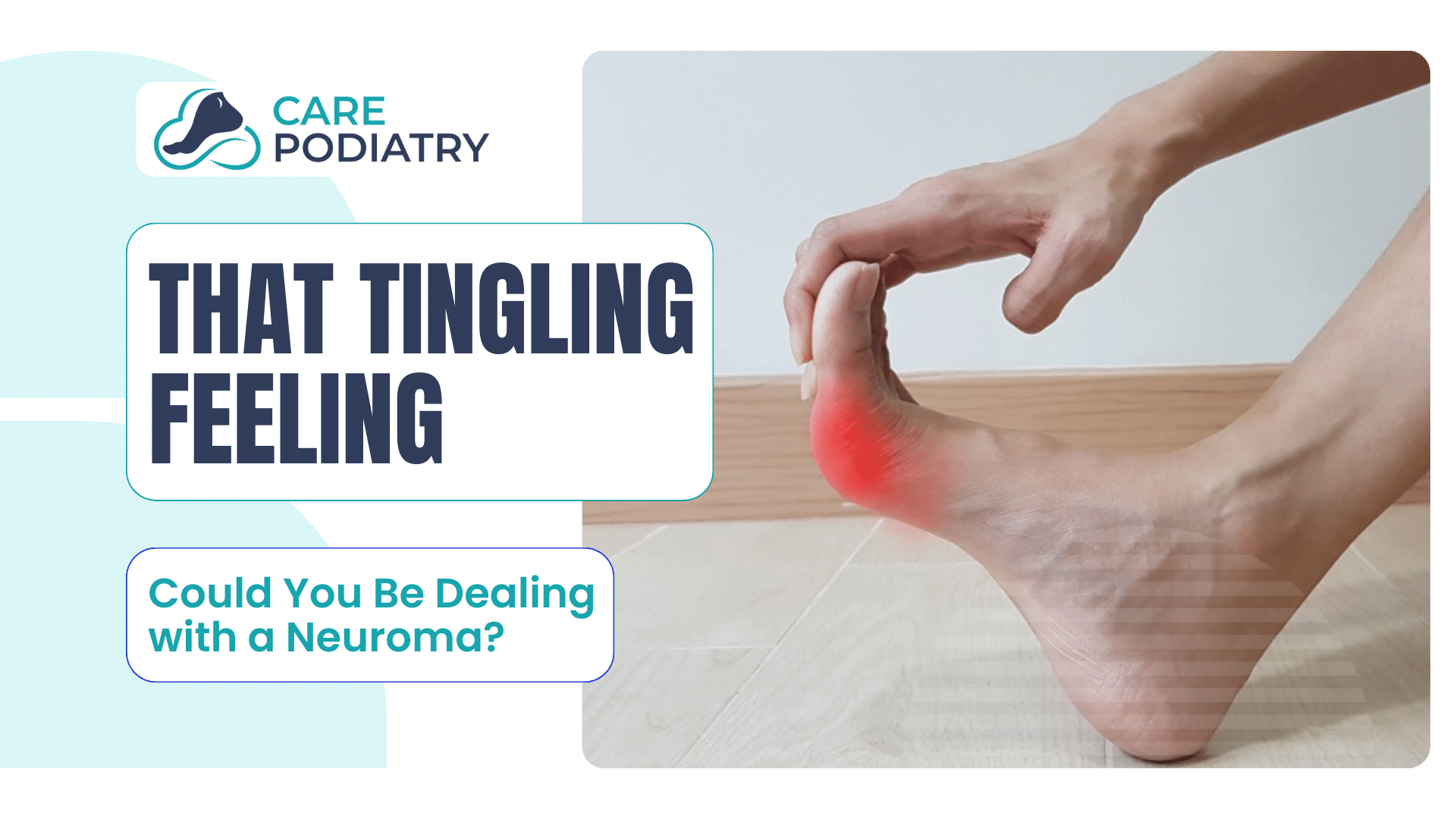Experiencing an unexplained tingling sensation in your foot could be a sign of a neuroma. A neuroma is a benign, non‑cancerous nerve lesion, often resulting from nerve injury, compression, or chronic irritation.
While neuromas can develop in various parts of the body, one of the most frequently encountered forms is Morton’s neuroma, a compressive neuropathy of the interdigital nerve in the forefoot. Affecting approximately 4% of the general population, this condition disproportionately affects middle‑aged women, with incidence rates significantly higher among females.
Understanding whether your tingling may be due to a neuroma is the first step toward tailored treatment and long-term relief. In this blog, we will understand what a neuroma is and why it occurs, and how you can detect the symptoms early enough.
What Is a Neuroma?
A neuroma is an enlargement of the tissue that surrounds one of the nerves going to your toes. The most typical is Morton’s neuroma, which normally appears between the third and fourth toes. It is not a tumor in cancerous terms, only a painful but benign irritation of the nerves due to compression or repetitive stress.
The irritation or swelling of the nerve is capable of causing sensations such as burning, tingling, numbness, or acute pain in the ball of the foot. Without treatment, the symptoms may degenerate and even impair your capability to walk normally.
Why Do Neuromas Develop?
Neuromas are usually associated with irritation, damage, or pressure to the nerve. The usual causes of the condition are:
- Wearing shoes that squash the toes together, i.e., narrow or high-heeled shoes.
- Running, tennis, or dancing: sports that lead to repetitive stress in the forefoot.
- Bunions, hammertoes, or flat feet are triggering foot deformities that change the distribution of pressure.
- Old injuries that bruise or disorder the nerves lying in the foot.
These factors can eventually cause strain on the nerve enough to cause inflammation and pain.
Recognizing the Common Symptoms of Neuroma
The symptoms of a neuroma may take their time to build up. In the early stages, you may feel slight tingling or numbness in your toes, which may come on and off. These symptoms can be chronic or become stronger with time.
Common symptoms include:
- Tingling or numbness between the toes.
- A burning sensation in the ball of the foot.
- Feeling like there’s a pebble in your shoe.
- When standing for extended periods of time or wearing tight shoes, the pain gets worse.
Neuroma or Something Else?
Due to leads that overlap with other foot problems, neuromas have been misdiagnosed. The same discomfort may be caused by conditions like metatarsalgia, stress fractures, arthritis, or even peripheral neuropathy.
Here’s a quick comparison:
| Condition | Key Symptom | Typical Cause |
|---|---|---|
| Morton’s Neuroma | Tingling/burning between toes, pebble-like feeling | Nerve compression |
| Metatarsalgia | Aching pain in the ball of the foot | Overuse, high-impact activity |
| Stress Fracture | Localized sharp pain, swelling | Bone cracks from repetitive stress |
| Neuropathy | Numbness, tingling, burning in feet | Nerve damage from diabetes or other systemic issues |
A podiatrist may carry out a physical examination, gently press the area, and perform an imaging test to strengthen the diagnosis.
How Are Neuromas Diagnosed?
Diagnosis of a neuroma begins with knowing your symptoms and any footwear patterns, and then a physical examination will be performed to ascertain tenderness or sensitivity of the nerves. A diagnosis can be made early by imaging the affected body part, whether it is an ultrasound or MRI, to show the thickened nerve tissue.
Diagnosis steps often include:
- Symptom review: At what time did the pain begin, which types of shoes were worn, and activity history
- Physical exam: Palpation to induce symptoms and ascertain swelling
- Imaging: Ultrasound or MRI to confirm what is seen
An early diagnosis frequently results in straightforward treatments that are not invasive.
What are the Treatment Options for Neuromas?
Treatment is done depending on the severity of the symptoms. Conservative care is able to decrease the pain and prevent further development in many instances.
- Swapping shoes changes: Shoes that fit better in the toe box with nice cushioning. Many times shoe heels can cause pain.
- Custom orthotics: These have inserts that relieve pressure off the affected nerve.
- Padding and taping: To unload the forefoot.
- Non-steroidal anti-inflammatory medication: To reduce any swelling and pain.
- Physical therapy: Slow stretching and strengthening activities to boost the foot mechanism.
- Corticosteroid Injections: It is used in cases of severe inflammation.
When conservative treatment fails to reduce the symptoms, surgery could be undertaken to excise the neuroma.
Prevention Tips for Neuroma
The prevention of neuroma may boil down to maintaining your feet away from consistent compression and pressure. It is possible to prevent the occurrence of this sore feet condition by properly choosing shoes, inserts, and paying attention to the pain in the feet in time.
Helpful habits:
- Wearing properly fitting shoes that have low heels and that have a wide area at the toes.
- Using supportive footwear when doing sports or other high-impact activities.
- Wear shoes that are neither too tight or narrow, but neither too long.
- To keep forefoot pressure at a low level, it is essential to maintain a healthy weight.
- Addressing foot deformities early to prevent nerve irritation.
Conclusion
By making certain lifestyle changes and taking medications, you can greatly alleviate your symptoms with a diagnosed neuroma. Orthotics and changing of shoes give relief to many individuals. A routine visit with a podiatrist should be done to ensure the condition is being monitored and not escalated.
Keep in mind, foot tingling or burning is not just fatigued feet. The long-term nerve damage must also be avoided by checking for persistent symptoms early.
If you suspect a neuroma, book your appointment with Care Podiatry today. Let’s get you walking comfortably again.
Frequently Asked Questions
Does Morton's neuroma make your feet tingle?
Yes. Morton’s neuroma is painful since it affects the nerve between your toes and usually affects the ball of your foot through tingling sensation, numbness, or even burning pain when you wear tight footwear.
What is the way to verify a neuroma?
It is checked by a podiatrist based on physical examination, symptoms analysis, and maybe by using imaging techniques, such as ultrasound and MRI, to find thickened nerves between the toes. Other activities can eliminate fractures, arthritis, or problems related to the nerves.
What is the difference between neuropathy and Morton's neuroma?
Neuropathy typically symmetrically affects the feet and is associated with whole-body problems such as diabetes. The problem of Morton’s neuroma is local, meaning that it is concentrated in a certain place between the toes and gets aggravated by some footwear.
Which widely spread conditions may be confused with neuromas?
The symptoms of neuroma could be replicated by metatarsalgia, stress fractures, arthritis, and peripheral neuropathy, and that is why a professional assessment is relevant to proper diagnosis and treatment.
How can you tell whether you have a neuroma in the foot?
Common symptoms are tingling, numbness, or burning, and the feeling of a pebble in your shoe, which tends to occur between the third and fourth toes, aggravated by snug shoes.



